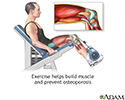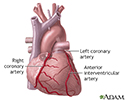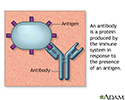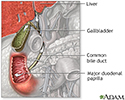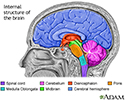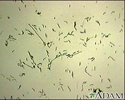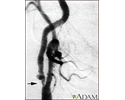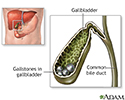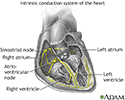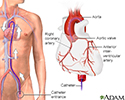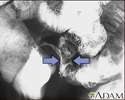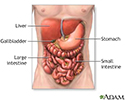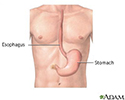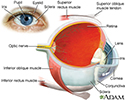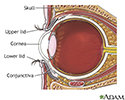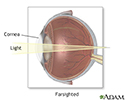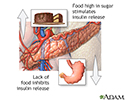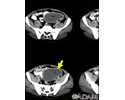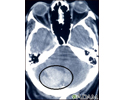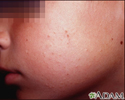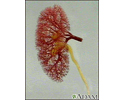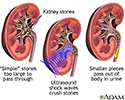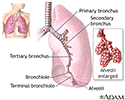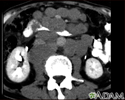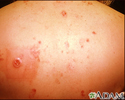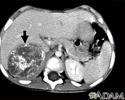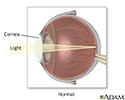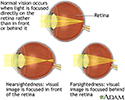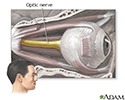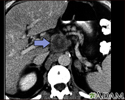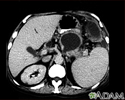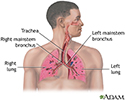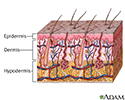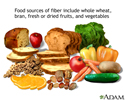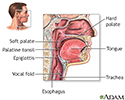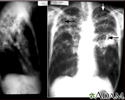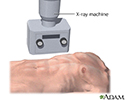Multimedia Gallery




Bone fracture repair - series
Bone fracture repair - series
Fractures of the bones are classified in a number of ways. A simple fracture involves a single fracture line through a bone. A comminuted fracture is one in which the bone has been fractured into two or more fragments. An open fracture is one in which the fractured bone penetrates the skin.
Bone fracture repair - series
Bone fracture repair - series
Fractures of the bones are classified in a number of ways. A simple fracture involves a single fracture line through a bone. A comminuted fracture is...
Bone fracture repair - series
Procedure, part 1
The three main treatment options for bone fractures are:
- Casting.
- Open reduction, and internal fixation- this involves a surgery to repair the fracture-frequently, metal rods, screws or plates are used to repair the bone, and remain in place, under the skin, after the surgery. This procedure is recommended for complicated fractures not able to be realigned (reduced) by casting, or in cases in which the long-term use of a cast is undesirable.
- Open reduction, and external fixation- this involves a surgery to repair the fracture, and placement of a external fixation device on the limb with the fracture. This device is an external frame which supports the bone and hold it in the correct position while it is healing. This technique is generally applied to complex fractures that cannot be repaired using open reduction, and internal fixation.
Bone fracture repair - series
Procedure, part 1
The three main treatment options for bone fractures are:Casting.Open reduction, and internal fixation- this involves a surgery to repair the fracture...
Bone fracture repair - series
Procedure, part 2
While the patient is pain-free (general or local anesthesia), an incision is made over the fractured bone. The bone is placed in proper position and screws, pins, or plates are attached to or in the bone temporarily or permanently. Any disrupted blood vessels are tied off or burned (cauterized). If examination of the fracture shows that a quantity of bone has been lost as a result of the fracture, especially if there is a gap between the broken bone ends, the surgeon may decide that a bone graft is essential to avoid delayed healing.
If bone grafting is not necessary, the fracture can be repaired by the following methods:
a) one or more screws inserted across the break to hold it.
b) a steel plate held by screws drilled into the bone.
c) a long fluted metal pin with holes in it, is driven down the shaft of the bone from one end, with screws then passed through the bone and through a hole in the pin.
In some cases, after this stabilization, the microsurgical repair of blood vessels and nerves is necessary. The skin incision is then closed in the usual fashion.
Bone fracture repair - series
Procedure, part 2
While the patient is pain-free (general or local anesthesia), an incision is made over the fractured bone. The bone is placed in proper position and ...
Bone fracture repair - series
Aftercare
The advantage of internal fixation is that it often allows early mobility and faster healing. Unless the internal fixation causes problems, it is not necessary or desirable to remove it. The long-term prognosis is excellent. The length of the hospital stay depends on factors such as the condition of the bone, the presence of infection, the state of the blood and nerve supply, and presence of other injuries. Children's bones heal rapidly, usually in 6 weeks time.
Bone fracture repair - series
Aftercare
The advantage of internal fixation is that it often allows early mobility and faster healing. Unless the internal fixation causes problems, it is not...
Review Date: 6/17/2024
Reviewed By: C. Benjamin Ma, MD, Professor, Chief, Sports Medicine and Shoulder Service, UCSF Department of Orthopaedic Surgery, San Francisco, CA. Also reviewed by David C. Dugdale, MD, Medical Director, Brenda Conaway, Editorial Director, and the A.D.A.M. Editorial team.
Fractures of the bones are classified in a number of ways. A simple fracture involves a single fracture line through a bone. A comminuted fracture is one in which the bone has been fractured into two or more fragments. An open fracture is one in which the fractured bone penetrates the skin.
The three main treatment options for bone fractures are:
- Casting.
- Open reduction, and internal fixation- this involves a surgery to repair the fracture-frequently, metal rods, screws or plates are used to repair the bone, and remain in place, under the skin, after the surgery. This procedure is recommended for complicated fractures not able to be realigned (reduced) by casting, or in cases in which the long-term use of a cast is undesirable.
- Open reduction, and external fixation- this involves a surgery to repair the fracture, and placement of a external fixation device on the limb with the fracture. This device is an external frame which supports the bone and hold it in the correct position while it is healing. This technique is generally applied to complex fractures that cannot be repaired using open reduction, and internal fixation.
While the patient is pain-free (general or local anesthesia), an incision is made over the fractured bone. The bone is placed in proper position and screws, pins, or plates are attached to or in the bone temporarily or permanently. Any disrupted blood vessels are tied off or burned (cauterized). If examination of the fracture shows that a quantity of bone has been lost as a result of the fracture, especially if there is a gap between the broken bone ends, the surgeon may decide that a bone graft is essential to avoid delayed healing.
If bone grafting is not necessary, the fracture can be repaired by the following methods:
a) one or more screws inserted across the break to hold it.
b) a steel plate held by screws drilled into the bone.
c) a long fluted metal pin with holes in it, is driven down the shaft of the bone from one end, with screws then passed through the bone and through a hole in the pin.
In some cases, after this stabilization, the microsurgical repair of blood vessels and nerves is necessary. The skin incision is then closed in the usual fashion.
The advantage of internal fixation is that it often allows early mobility and faster healing. Unless the internal fixation causes problems, it is not necessary or desirable to remove it. The long-term prognosis is excellent. The length of the hospital stay depends on factors such as the condition of the bone, the presence of infection, the state of the blood and nerve supply, and presence of other injuries. Children's bones heal rapidly, usually in 6 weeks time.




Animations
- Alzheimer disease
- Arrhythmias
- Atherosclerosis
- Balloon angioplasty - short...
- Blood clotting
- Blood flow
- Blood pressure
- Cancer of the throat or larynx
- Cardiac conduction system
- Cardiomyopathy
- Cardiovascular system
- Cataract
- Cerebral aneurysm
- Coronary artery bypass graf...
- Coronary artery disease
- Diabetes - retinal conditions
- Directional coronary athere...
- Enlarged prostate gland
- Glaucoma
- Gout
- Heart bypass surgery
- Heartbeat
- Heartburn
- Herniated nucleus pulposus ...
- Hypertension - overview
- Kidney stones
- Macular degeneration
- Osteoarthritis
- Osteoporosis
- Parkinson disease
- Percutaneous transluminal c...
- Retinal detachment
- Skin conditions
- Smoking
- Stomach ulcer
- Stomach ulcer
- Stroke
- Stroke - secondary to cardi...
- Sun's effect on skin
- Tachycardia
- Tobacco use - effects on ar...
- Vasectomy
Illustrations
- 15/15 rule
- Abdominal organs
- Abdominal quadrants
- Abdominal ultrasound
- Abdominal ultrasound
- Abnormal discharge from the...
- Actinic keratosis - close-up
- Actinic keratosis - ear
- Actinic keratosis on the arm
- Actinic keratosis on the fo...
- Actinic keratosis on the scalp
- Active vs. inactive muscle
- Acute MI
- Adenocarcinoma
- Adenocarcinoma - chest x-ray
- Adult dermatome
- Aerobic exercise
- Aged eye anatomy
- Aged hair follicle
- Aged male reproductive system
- Aging and exercise
- Aging changes in hearing
- Aging changes in nails
- Alcohol and diet
- Alcohol use disorder
- Alcoholic neuropathy
- Alcoholism
- Allergic reactions to medication
- Alopecia areata with pustules
- Alopecia totalis - back vie...
- Alopecia totalis - front vi...
- Alopecia, under treatment
- Alpha-glucosidase inhibitors
- Alzheimer disease
- Amyloidosis of the fingers
- Anaphylaxis
- Anatomical landmarks adult ...
- Angina
- Ankle anatomy
- Ankle replacement
- Ankle sprain
- Ankle sprain swelling
- Anorectal fistulas
- Anterior heart arteries
- Anterior skeletal anatomy
- Anterior vaginal wall repair
- Antibodies
- Aortic aneurysm
- Aortic dissection
- Aortic insufficiency
- Aortic rupture - chest x-ray
- Aortic stenosis
- Appendicitis
- Arterial embolism
- Arterial plaque build-up
- Arterial tear in internal c...
- Arteries of the brain
- Artery cut section
- Arthritis in hip
- Ascites with ovarian cancer...
- Asthma
- Asthmatic bronchiole and no...
- Atherosclerosis
- Atherosclerosis of internal...
- Atherosclerosis of the extr...
- Atopic dermatitis
- Atopy on the ankles
- Atrioventricular block - EC...
- Auer rods
- Autonomic Nerves
- Baker cyst
- Balance receptors
- Barium enema
- Barium enema
- Barium ingestion
- Basal cell cancer
- Basal cell carcinoma - close-up
- Basal Cell Carcinoma - face
- Basal cell nevus syndrome -...
- Basal cell nevus syndrome -...
- Basal cell nevus syndrome -...
- Basophil (close-up)
- Before and after corneal surgery
- Before and after hematoma repair
- Benign juvenile melanoma
- Bicycle helmet - proper usage
- Biguanides
- Bile pathway
- Biopsy catheter
- Bladder biopsy
- Bladder catheterization - female
- Bladder catheterization - male
- Blood cells
- Blood gases test
- Blood pressure
- Blood pressure check
- Blood test
- Bloodshot eyes
- Bone density scan
- Bone marrow aspiration
- Bone marrow from hip
- Bone-building exercise
- Bowen's disease on the hand
- BPH
- Bradycardia
- Brain
- Brain and nervous system
- Brain structures
- Brain wave monitor
- Brainstem function
- Brain-thyroid link
- Breast lumps
- Breast pain
- Breast self-exam
- Breast self-exam
- Breast self-exam
- Breath sounds
- Brittle nails
- Bronchial cancer - chest x-ray
- Bronchial cancer - CT scan
- Bronchitis
- Bronchoscope
- Bronchoscopy
- Bullous pemphigoid - close-...
- Bursa of the elbow
- Bursa of the knee
- Bursitis of the shoulder
- Calcium and bones
- Calcium benefit
- Calcium source
- Calculating body frame size
- Calories and fat per serving
- Campylobacter jejuni organism
- Cardiac arteriogram
- Cardiac catheterization
- Cardiac catheterization
- Carotid artery anatomy
- Carotid duplex
- Carotid stenosis - X-ray of...
- Carotid stenosis - X-ray of...
- Carpal tunnel syndrome
- Cataract
- Cataract
- Cataract - close-up of the eye
- Cauda equina
- Cause of peptic ulcers
- Causes of acute bronchitis
- Causes of breast lumps
- Causes of chronic bronchitis
- Central nervous system and ...
- Cerebellum - function
- Cerebral aneurysm
- Cerebral aneurysm
- Cervical biopsy
- Cervical cancer
- Cervical cancer
- Cervical neoplasia
- Cervical spondylosis
- Cervical vertebrae
- Changes in face with age
- Changes in face with age
- Changes in kidney with age
- Changes in lung tissue with age
- Changes in spine with age
- Check airway
- Cheilitis - actinic
- Chest stretch
- Chest tube insertion
- Cholecystitis - cholangiogram
- Cholecystitis, CT scan
- Cholecystolithiasis
- Cholelithiasis
- Cholesterol
- Cholesterol producers
- Chondromalacia of the patella
- Chronic hepatitis
- Chronic lymphocytic leukemi...
- Circle of Willis
- Circulation of blood throug...
- Circulation of lymph
- Circulatory system
- Cirrhosis of the liver
- Cloudy cornea
- Clubbing
- Coal worker's lungs - chest...
- Coal workers pneumoconiosis...
- Coal workers pneumoconiosis...
- Coal workers pneumoconiosis...
- Coal workers pneumoconiosis...
- Coccidioidomycosis - chest x-ray
- Cold cone biopsy
- Cold symptoms
- Colon culture
- Colonoscopy
- Colonoscopy
- Common asthma triggers
- Compression fracture
- Concussion
- Conduction system of the heart
- COPD (chronic obstructive p...
- Corns and calluses
- Coronary angiography
- Coronary artery blockage
- Coronary artery disease
- Coronary artery disease
- Coronary artery spasm
- Coronary artery stent
- Craniotomy for cerebral shunt
- Crohn disease - affected areas
- Crohn disease - X-ray
- Crossed eyes
- Cryoglobulinemia of the fingers
- Cryptosporidium - organism
- CT scan
- Cystoscopy
- Damaged axillary nerve
- DASH diet
- Deep veins
- Deep veins
- Deep venous thrombosis - il...
- Depression among the elderly
- Depression and heart disease
- Depression and insomnia
- Depression and men
- Dermatitis - contact
- Dermatitis - pustular contact
- Dermatitis - stasis on the leg
- Dermatomyositis - Gottron papule
- Dermatomyositis - Gottron papule
- Dermatomyositis - Gottron's...
- Dermatomyositis - heliotrop...
- Dermatomyositis on the legs
- Detached retina
- Developmental process of at...
- Diabetes and exercise
- Diabetes and nerve damage
- Diabetic blood circulation ...
- Diabetic emergency supplies
- Diabetic nephropathy
- Diabetic retinopathy
- Diaphragm
- Diaphragm and lungs
- Diarrhea
- Different types of weight gain
- Digestive system
- Digestive system organs
- Dilated cardiomyopathy
- Diseased hip
- Donor liver attachment
- Doppler ultrasonography of ...
- Drug induced hypertension
- Drug rash - Tegretol
- Drug rash on the back
- Ear anatomy
- ECG
- Eczema, atopic - close-up
- Effects of age on blood pressure
- Elbow prosthesis
- Electrocardiogram (ECG)
- Electromyography
- Emphysema
- Endarterectomy
- Endocrine glands
- Endometrial biopsy
- Endometrial cancer
- Enlarged view of atherosclerosis
- Esophagus and stomach anatomy
- Ewing sarcoma - x-ray
- Exercise - a powerful tool
- Exercise - dress appropriately
- Exercise 30 minutes a day
- Exercise with friends
- Exercise-induced asthma
- External and internal eye a...
- External fixation device
- Eye
- Eye anatomy
- Eye muscles
- Facial drooping
- Farsighted
- Fatty liver - CT scan
- Female breast
- Female perineal anatomy
- Female reproductive anatomy
- Female reproductive anatomy
- Female urinary tract
- Female-pattern baldness
- Fibroadenoma
- Fibrocystic breast change
- Fish in diet
- Fixed drug eruption
- Fixed drug eruption - bullous
- Fixed drug eruption on the cheek
- Folliculitis - decalvans on...
- Food and insulin release
- Foot swelling
- Formed elements of blood
- Forms of depression
- Foxglove (Digitalis purpurea)
- Fracture types (1)
- Fracture types (2)
- Fracture, forearm - x-ray
- Fractures across a growth plate
- Fruits and vegetables
- Gallbladder
- Gallbladder radionuclide scan
- Gallium injection
- Gallstones
- Gallstones, cholangiogram
- Gastric endoscopy
- Gastroesophageal reflux disease
- Gastroscopy procedure
- Generalized anxiety disorder
- Gianotti-Crosti syndrome on...
- Glaucoma
- Glossopharyngeal neuralgia
- Glucose in blood
- Goiter
- Groin stretch
- Hair follicle
- Half and half nails
- Hamstring stretch
- Head and neck glands
- Head CT
- Head injury
- Head MRI
- Head trauma
- Headache
- Healthy diet
- Hearing aids
- Heart - front view
- Heart - section through the...
- Heart attack symptoms
- Heart beat
- Heart chambers
- Heart valves
- Heart valves - anterior view
- Heart valves - superior view
- Heartburn prevention
- Hemoglobin
- Hemorrhoids
- Hepatitis A
- Hepatitis B
- Hepatitis B virus
- Hepatitis C
- Hepatocellular cancer - CT scan
- Herniated disk repair
- Herniated nucleus pulposus
- Herpes zoster (shingles) - ...
- Herpes zoster (shingles) di...
- Herpes zoster (shingles) on...
- Herpes zoster (shingles) on...
- Herpes zoster (shingles) on...
- Hiatal hernia
- Hiatal hernia - x-ray
- High blood pressure tests
- Hip fracture
- Hip stretch
- Hives
- Holter heart monitor
- Hospital-acquired pneumonia
- Hyperlinearity in atopic de...
- Hyperplasia
- Hypertension
- Hypertensive retinopathy
- Hypertrophic cardiomyopathy
- Hypothyroidism
- Hysterectomy
- Immune system structures
- Immune system structures
- Impingement syndrome
- Implantable cardioverter-de...
- Indications of head injury
- Infectious mononucleosis
- Inflamed shoulder tendons
- Inflammatory bowel disease
- Inflatable artificial sphincter
- Influenza
- Inguinal hernia
- Insulin production and diabetes
- Insulin pump
- Internal fixation devices
- Intervertebral disk
- Intestinal gas
- Intra-abdominal abscess - C...
- Intracerebellar hemorrhage ...
- Intravenous pyelogram
- Intravenous pyelogram (IVP)
- Intussusception - x-ray
- Irregular sleep
- Islets of Langerhans
- Isometric exercise
- Janeway lesion - close-up
- Janeway lesion on the finger
- Keratoacanthoma
- Keratoacanthoma
- Keratosis pilaris - close-up
- Keratosis pilaris on the cheek
- Kidney - blood and urine flow
- Kidney anatomy
- Kidney blood supply
- Kidney cyst with gallstones...
- Kidney function
- Kidney metastases - CT scan
- Kidney tumor - CT scan
- Kidneys
- Knee arthroscopy
- Knee joint
- Knee joint replacement pros...
- Knee pain
- Koilonychia
- Kyphosis
- Large intestine (colon)
- Large intestine anatomy
- Left atrial myxoma
- Left cerebral hemisphere - ...
- Leg pain (Osgood-Schlatter)
- Leg skeletal anatomy
- Lentigo - solar on the back
- Lentigo - solar with erythe...
- Lifestyle changes
- Limbic system
- Lipocytes (fat cells)
- Lipoma - arm
- Lithotripsy procedure
- Liver anatomy
- Liver biopsy
- Liver blood supply
- Liver cirrhosis - CT scan
- Liver metastases, CT scan
- Liver with disproportional ...
- Lobes of the brain
- Location of peptic ulcers
- Low blood sugar symptoms
- Lower digestive anatomy
- Lower leg muscles
- Lumbar vertebrae
- Lumpectomy
- Lung biopsy
- Lung cancer - chemotherapy ...
- Lung cancer - frontal chest...
- Lung cancer - lateral chest...
- Lung mass, right lung - CT scan
- Lung mass, right upper lobe...
- Lung mass, right upper lung...
- Lung nodule - front view ch...
- Lung nodule, right lower lu...
- Lung nodule, right middle l...
- Lung with squamous cell can...
- Lungs
- Lymph node metastases, CT scan
- Lymph tissue in the head an...
- Lymphatic system
- Lymphatic system
- Lymphoma, malignant - CT scan
- Macular degeneration
- Malaria, microscopic view o...
- Malaria, photomicrograph of...
- Male pattern baldness
- Male reproductive anatomy
- Male reproductive system
- Male urinary system
- Male urinary tract
- Mammary gland
- Mammogram
- Mammography
- Mastoiditis - redness and s...
- Mastoiditis - side view of head
- Meckel diverticulum
- Medical findings based on e...
- Megaloblastic anemia - view...
- Melanoma
- Melanoma of the liver - MRI scan
- Memory tips
- Menopause
- Middle ear infection (otiti...
- Mitral stenosis
- Mitral valve prolapse
- Monitoring blood pressure
- Motor nerves
- Mouth anatomy
- MRI scans
- MUGA test
- Multiple basal cell cancer ...
- Muscular atrophy
- Myocarditis
- Nail infection - candidal
- Nasal spray flu vaccine
- Neck lump
- Neck pain
- Needle biopsy of the breast
- Nephrolithiasis
- Nervous system
- Nervous system
- Neuroblastoma in the liver ...
- Neurofibromatosis I - enlar...
- Non-small cell carcinoma
- Normal anatomy of the heart
- Normal external abdomen
- Normal foot x-ray
- Normal heart anatomy (cut s...
- Normal heart rhythm
- Normal lung anatomy
- Normal lung anatomy
- Normal lungs and alveoli
- Normal rotator cuff anatomy
- Normal uterine anatomy (cut...
- Normal vision
- Normal, nearsightedness, an...
- Nuclear scan
- Obesity and health
- Obstructive sleep apnea
- Onycholysis
- Open biopsy of the breast
- Optic nerve
- Oral anatomy
- Oral glucose tolerance test
- Oropharynx
- Osteoarthritis
- Osteoarthritis
- Osteoarthritis vs. rheumato...
- Osteogenic sarcoma - x-ray
- Osteomyelitis
- Osteoporosis
- Osteoporosis
- Ovalocytosis
- Ovarian cancer
- Ovarian cancer dangers
- Ovarian cancer metastasis
- Ovarian growth worries
- Pacemaker
- Pancreas
- Pancreas
- Pancreas and kidneys
- Pancreatic cancer, CT scan
- Pancreatic pseudocyst - CT scan
- Pancreatic, cystic adenoma ...
- Pap smear
- Pap smear
- Parathyroid glands
- Paronychia - candidial
- Peak flow meter
- Pelvic adhesions
- Pelvic laparoscopy
- Pemphigus vulgaris - lesion...
- Pemphigus vulgaris on the back
- Peripartum cardiomyopathy
- Peritoneal and ovarian canc...
- Pitting edema on the leg
- Plantar fascia
- Plantar fasciitis
- Plantar wart
- Plaque buildup in arteries
- Pleural cavity
- Pneumococci organism
- Pneumonia
- Post myocardial infarction ...
- Posterior heart arteries
- Prevention of cystitis
- Prevention of heart disease
- Progressive build-up of pla...
- Prostate cancer
- Prostate cancer
- Prostate gland
- PSA blood test
- Psoriasis - guttate on the ...
- Psoriasis - guttate on the cheek
- Psoriasis on the knuckles
- Ptosis - drooping of the eyelid
- Pulmonary embolus
- Pulmonary mass - side view ...
- Pulmonary nodule - front vi...
- Pulmonary nodule, solitary ...
- Pyogenic abscess
- Quitting smoking
- Radial pulse
- Rectal biopsy
- Rectal cancer - x-ray
- Rectal prolapse
- Red blood cells - elliptocytosis
- Red blood cells - multiple ...
- Red blood cells - normal
- Red blood cells - sickle an...
- Red blood cells - sickle cells
- Red blood cells - spherocytosis
- Red blood cells, sickle cell
- Red blood cells, target cells
- Red blood cells, tear-drop shape
- Renal biopsy
- Respiratory cilia
- Respiratory system
- Reticulocytes
- Retina
- Retina
- Retrocalcaneal bursitis
- Rheumatoid arthritis
- Rheumatoid arthritis
- Rheumatoid arthritis
- Ribs and lung anatomy
- Right atrial myxoma
- Right cerebral hemisphere -...
- Ringworm, tinea capitis - c...
- Role of the vagus nerve in ...
- Rosacea
- Rotator cuff muscles
- Sarcoid, stage II - chest x-ray
- Sarcoid, stage IV - chest x-ray
- Schatzki ring - x-ray
- Sciatic nerve
- Sciatic nerve damage
- Scoliosis
- Secondhand smoke and lung cancer
- Sense of sight
- Sentinel node biopsy
- Shin splints
- Shingles
- Shoulder joint inflammation
- Side view of the eye (cut s...
- Sigmoid colon cancer - x-ray
- Sinuses
- Sinusitis
- Skeletal spine
- Skeleton
- Skin cancer - close-up of l...
- Skin cancer - close-up of l...
- Skin cancer - malignant melanoma
- Skin cancer - melanoma supe...
- Skin cancer - raised multi-...
- Skin cancer - squamous cell...
- Skin cancer, basal cell car...
- Skin cancer, basal cell car...
- Skin cancer, basal cell car...
- Skin cancer, basal cell car...
- Skin cancer, close-up of le...
- Skin cancer, melanoma - fla...
- Skin cancer, melanoma - rai...
- Skin cancer, melanoma on th...
- Skin cancer, squamous cell ...
- Skin layers
- Skin lesion aspiration
- Skin lumps
- Skin tag
- Skin turgor
- Sleep patterns in the young...
- Slit-lamp exam
- Small cell carcinoma
- Small intestine
- Smoking hazards
- Smoking hazards
- Sources of fiber
- Spinal stenosis
- Spinal stenosis
- Spine supporting structures
- Spirometry
- Spleen and liver metastases...
- Sprained ankle
- Squamous cell cancer
- Squamous cell carcinoma
- Squamous cell carcinoma - i...
- St. John's Wort
- Stable angina
- Stages of cancer
- Starchy foods
- Stomach
- Stomach and stomach lining
- Stomach cancer, x-ray
- Stomach disease or trauma
- Stomach ulcer, x-ray
- Stopping bleeding with a to...
- Stopping bleeding with dire...
- Stopping bleeding with pres...
- Stress and anxiety
- Stress incontinence
- Stress incontinence
- Stroke
- Structure of the colon
- Stye
- Subdural hematoma
- Substantia nigra and Parkin...
- Subungual wart
- Sulfonylureas drug
- Superficial anterior muscles
- Swollen glands
- Swollen gums
- Swollen lymph nodes in the groin
- Swollen lymph nodes under arm
- Taking your carotid pulse
- Tendinitis
- Tendon vs. ligament
- Tendonitis
- The large intestine
- The structure of a joint
- Thiazolidinediones
- Thigh stretch
- Throat anatomy
- Thrombus
- Thyroid cancer - CT scan
- Thyroid cancer - CT scan
- Thyroid enlargement - scintiscan
- Thyroid function test
- Thyroid gland
- Tissue types
- Tobacco and cancer
- Tobacco and chemicals
- Tobacco and vascular disease
- Tobacco health risks
- Tongue
- Tooth anatomy
- Torn rotator cuff
- Transient Ischemic attack (TIA)
- Triceps stretch
- Trichotillomania - top of t...
- Tuberculosis, advanced - ch...
- Tympanic membrane
- Type I diabetes
- Ulcer emergencies
- Ulcerative colitis
- Untreated hypertension
- Upper gastrointestinal system
- Uterus
- Varicose veins
- Venous blood clot
- Venous insufficiency
- Ventricles of the brain
- Ventricular tachycardia
- Vertebra, cervical (neck)
- Vertebra, lumbar (low back)
- Vertebra, thoracic (mid back)
- Vertebral column
- Vertigo
- Visual acuity test
- Visual field test
- Vitamin D benefit
- Vitamin D deficit
- Vitamin D source
- Volvulus - x-ray
- Walking for health
- Warming up and cooling down
- Wart
- Wart (close-up)
- Wart (verruca) with a cutan...
- Warts - flat on the cheek a...
- Warts, multiple - on hands
- Wax blockage in the ear
- White nail syndrome
- Wrist splint
- X-ray
- X-ray
- Yellow nail syndrome
- Yellow nails
- Yoga
Presentations
- Abdominal exploration - series
- Arterial bypass leg - series
- Biliary obstruction - series
- Blepharoplasty - series
- Bone fracture repair - series
- Bone-marrow transplant - series
- Breast lump removal - series
- Breast reconstruction - series
- Carotid artery surgery - series
- Cataract surgery - series
- Chest tube insertion - series
- Colon cancer - series
- Colon diverticula - series
- Colostomy - series
- Complete blood count - series
- Corneal transplant - series
- Coronary artery balloon ang...
- Craniotomy - series
- Eardrum repair - series
- Facelift - series
- Forehead lift - series
- Gallbladder removal - Series
- Gastrectomy - series
- GI bleeding - series
- Heart bypass surgery - series
- Heart transplant - series
- Heart valve surgery - series
- Hemorrhoid surgery - series
- Hiatal hernia repair - series
- Hip joint replacement - series
- Inflammatory bowel disease ...
- Inguinal hernia repair - series
- Kidney removal (nephrectomy...
- Kidney transplant - series
- Knee arthroscopy - series
- Knee joint replacement - series
- Large bowel resection - series
- Liver transplant - series
- Lumbar spinal surgery - series
- Lung transplant - series
- Mastectomy - series
- Mastoidectomy - series
- Metered dose inhaler use - ...
- Microdiskectomy - series
- Monitoring blood glucose - ...
- Nebulizer use - series
- Pancreas transplant - series
- Partial knee replacement - ...
- Peak flow meter use - Series
- Prostatectomy - Series
- Pulmonary lobectomy - series
- Rectal prolapse repair - series
- Retinal detachment repair ...
- Shoulder separation - series
- Skin smoothing surgery - series
- Small bowel resection - series
- Spacer use - Series
- Spinal fusion - series
- Stroke - series
- Transurethral resection of ...
- Venous thrombosis - series
- Ventriculoperitoneal shunt ...

 Bookmark
Bookmark






























































